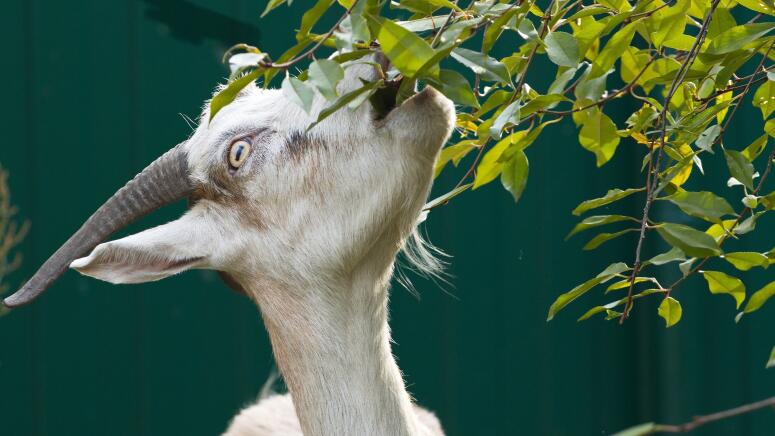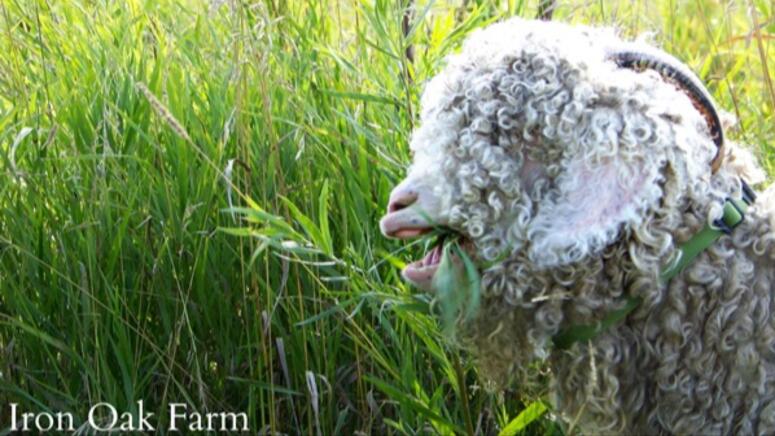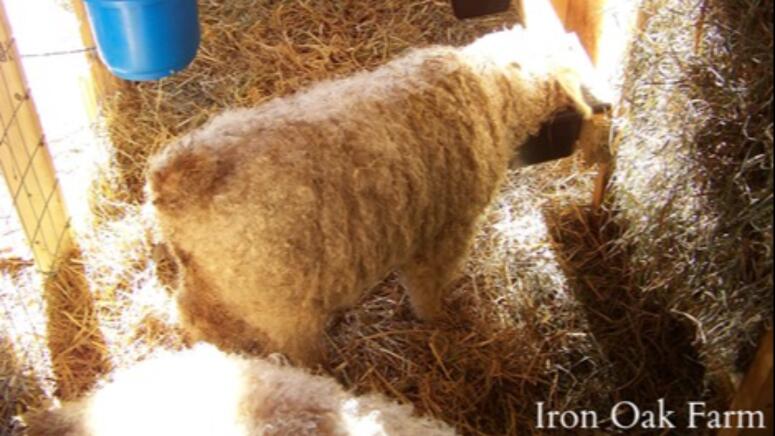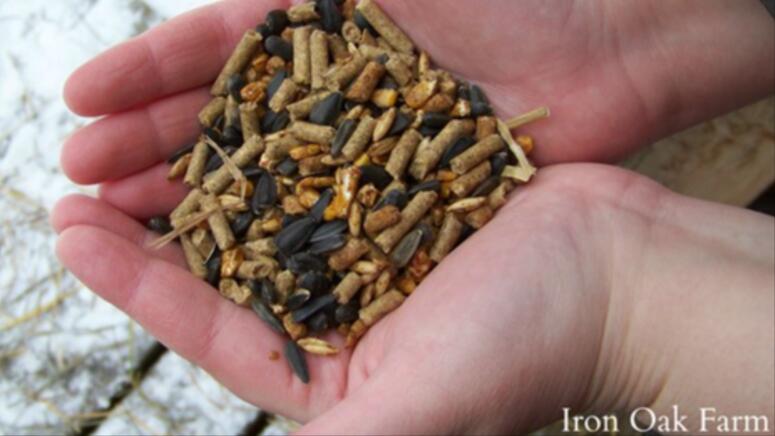
Posted by Jennifer Sartell, Professional Homesteader & Blogger, Tue, Aug 2, 2016
Feeding a herd of goats can be tricky. Goats have a complex digestive system that requires different types and amounts of food to run smoothly. When you enter the goat world, it seems that everyone has an opinion on what is the “best” way to feed.
As a result, it can be confusing to know what is right for your animals. In this post, I break down the different options for meeting a goat’s nutritional needs so that you can decide for yourself what is the best method for your herd. I also share a bit about what has worked for us and what we’d like to improve on when it comes to goat nutrition.
Feed Components for Our Herd
These ratios change when winter arrives and pasture is not available.
- Grass Hay: 50%
- Pasture: 25%
- Grain: 20%
- Treats: 5% or less
Hay
When keeping domestic goats, hay is essential for two reasons: It provides both nutrition and dry roughage to balance the moisture and fiber content in the rumen.
Hay vs. Straw
I often hear the terms “hay” and “straw” used interchangeably, and I cringe. Thankfully, it’s usually from people who don’t keep animals. But just in case, or if you’re new to raising goats, it’s important to know the difference as well as why you should include them in your goat’s diet.
- Hay is grass that has been cut and dried, then baled or collected to use as animal feed. Much of the nutrition in the grass is preserved in the hay, and it makes great feed for goats. Think of it as dehydrated pasture. It’s usually grayish green and dull in color.
- Straw is the collection of stalks left over after grain kernels have been harvested for food. Straw is a by-product of the grain harvest (like wheat, for example). It has little to no nutritional value and is used for bedding.
Straw makes for great bedding because it is nice and fluffy as well as insulating because each straw is hollow, trapping warm air pockets in the tubes. Straw is also slightly slippery in texture, so manure and wetness fall through the straw and away from the animals. It also doesn’t rot or mold as quickly as hay.
Straw is golden and shiny. You do not want to feed it to your animals. They may nibble a piece now and then, but it should not be a source of nutrition.
Brown Hay
Some browning of the hay is normal, but excess or very brown hay is low in nutrition and you may be wasting your money. Brown hay means that the elements were not ideal while the farmer was baling.
Either it was sun-bleached, or it was rained on during the drying process. Rain will actually “wash” away nutrition and color from the grass blades. Brown hay can also be the result of old hay that has been stored too long or in improper conditions.
Never feed moldy hay to goats! It can cause digestive and respiratory problems, among other things.
Grass Hay vs. Alfalfa
Grass hay may contain a blend of different grasses. You may hear of types such as timothy hay, orchard grass, canary grass, fescue, etc. Each of these grasses may be found in your hay bale. They hold different nutritional values as far as protein, fiber and minerals are concerned. Ask your hay supplier what is in the bales you are buying.
We hay our own field with a mix of grasses including orchard grass, timothy hay, some swamp grass and goldenrod, plus an under-layer of red clover. Each year we work to improve our field. This year, we plan to plow up sections and plant a hay mix seed so that we will have a better understanding of our hay’s nutritional content.
Our goats always have access to grass hay.
Alfalfa is a very rich fodder made of the dehydrated legume alfalfa. Its protein content is about double that of grass hay.
Most grass hay protein falls around 7–8%
Alfalfa protein is around 16%, which is similar to that of most manufactured grain blends.
In this way, some goat owners can eliminate the need for grain with alfalfa and good pasture. Alfalfa should not be fed on a free-choice basis, but portioned into flakes depending on the goat’s size and nutritional needs.

Pasture
Goats can thrive in a variety of living situations, but they do best when they are exposed to adequate pasture. In the wild, goats are grazers, which means that the herd moves throughout the day nibbling on tree branches, weeds, brambles, etc. For most of us, pasture means grass.
Goats do well on grass, but remember to introduce lush pasture slowly to allow their system to regulate the fresh wet green. Provide plenty of hay to help balance out the system.
In the spring, we allow our goats out for an hour at a time until they have adjusted to the new food after the lack thereof during the winter. Wet, lush pasture can be particularly hard on the system and may cause scours. Pasture rotation helps keep the plant cycle healthy and reduce worm problems.
Grain
In reality, goats were never meant to eat much grain. Goats are natural grazers; their systems are meant to digest shrubs, weeds, small tree branches, bark, leaves and some grasses. In nature, goats would have a hard time finding a mix of oats, corn, soybeans and sweet molasses.
But, in the same respect, dogs were never really meant to eat kibble. Dogs in the wild hunt deer and rabbits for food. They consume raw meat and chew bones for healthy marrow. But when you domesticate an animal, things change. It would be difficult to hunt for my dog every day and bring home freshly killed meat for his dinner. So, we improvise. Grain is a version of that adaptation.
Feeding grain ensures that a goat is getting enough nutrition. Most formulas provide around 16% protein. Feed amounts should be labeled on the bag according to the animal’s weight. Or you can discuss portions with your vet.
Does in milk, pregnant does, and fiber goats require more grain than bucks and wethers, though some bucks need additional nutrition because of the toll that hormone production takes on their bodies.
An increase in the amount of grain fed should be done gradually so as to prevent overwhelming the bacteria in the rumen.

Sweet Feed vs. Not
Sweet feed is a mix of whole grains or pelleted food tossed with molasses. The molasses makes the grain very palatable to goats; in fact, they can become obsessed with it! The molasses adds iron and sugars, and in some feed mill blends helps supplements, such as minerals or medications, to stick to the feed.
Our goats will turn their noses up at feed that isn’t coated in molasses. They also prefer a mix of whole oats and pellets rather than just pellet feed. Because goats love sweet feed, it can be used as a training tool. It helps them stay still on the stanchion during milking, shearing, hoof trimming and health checkups. It also encourages them to come when they are called. If the goats get into the garden, grab a bucket of sweet feed and shake it. They’ll be on your tail faster than you can say “tomato!”
Grain can also be useful for administering supplements. We sometimes add pelleted wormers to the goats’ grain ratio, or sprinkle probiotics to help with their immune systems. Our fiber goats get the addition of 5% black oil sunflower seeds to provide healthy fats for lanolin production. Lanolin is a waxy oil that helps protect the wool.

Sweet Feed and Urinary Calculi
Sweet Feed and grain can sometimes cause urinary calculi in goats, particularly wethers. Urinary calculi is when calculi or stones, usually comprised of phosphate salts, lodge in the urinary tract and prevent normal urination. The primary cause of urinary calculi is feeding a concentrated diets that is excessive in phosphorus and magnesium. (University of Kentucky)
Ways to Prevent Urinary Calculi
- Wait until male goats are older to wether. This allows the urinary tract to develop completely
- Make sure the goat’s diet is made up mostly of hay and roughage, and only supplemented with grain
- Check to see if ammonium chloride is one of the ingredients in their feed. If it’s not, ask your vet whether a supplement would be a good choice
- Provide plenty of fresh clean water at all times to help flush out the goat’s system.
- Also provide salt on a free-choice basis. Consumption of salt encourages consumption of water
Goat Treats
Treats make up a variety of foods that your goats don’t consume on a daily basis. Treats are given to our herd because we simply love our goats and love to spoil them. They are particularly fond of the new apple-flavored Manna Pro® Goat Treats.
Sometimes we use kitchen scraps or things we pick from the garden as goat treats. Some of our goats’ favorites are pumpkin and raspberry plants.
Some fruits and vegetables are not a good choice for goats. Consult your veterinarian for a list of safe treat choices. Treats should be given in small amounts. Any time you introduce a new food, do so gradually so that it doesn’t upset their tummies.
Once your goat’s diet is balanced, feeding is quite easy and becomes routine. With a basic outline about goat nutrition, you will soon learn what works for your goats and what doesn’t.
Author Profile: Jennifer Sartell
Jennifer Sartell is the primary caretaker of all animals on her and her husband’s farm in Fenton, MI. With a passion for living a simple life, Jennifer enjoys creating art, taking in nature, raising animals and has developed a deep appreciation for homesteading. Jennifer and her husband, Zach, currently raise goats and poultry.
Her vast amount of experience on the farm includes, but is not limited to: milking, shearing, hoof trimming, vaccine administration, assisting in animal births, dehorning, egg collecting, chick and turkey hatching, feeding, watering, etc. She can also cook a mean farm-to-table meal and when the day is done has documented and photographed their day on the farm.
More Blogs by Jennifer Sartell
- https://www.mannapro.com/homestead/caring-for-pregnant-does-part-2
- https://www.mannapro.com/homestead/caring-for-pregnant-does-part-1
- https://www.mannapro.com/homestead/preparing-caring-for-goats-in-winter
- https://www.mannapro.com/homestead/dairygoatbreeds
- https://www.mannapro.com/homestead/preparing-the-kidding-stall-part-2
- https://www.mannapro.com/homestead/a-guide-to-buying-a-new-goat
- https://www.mannapro.com/homestead/raising-kids-dehorning-wethering
- https://www.mannapro.com/homestead/milking-a-goat
- https://www.mannapro.com/homestead/raising-fiber-goats-101
- https://www.mannapro.com/homestead/hoof-care-for-goats
- https://www.mannapro.com/homestead/putting-together-a-goat-birthing-kit
- https://www.mannapro.com/homestead/preparing-the-kidding-stall-part-1
- https://www.mannapro.com/homestead/breaking-down-the-goat-diet
- https://www.mannapro.com/homestead/birthing-goat-kids
- https://www.mannapro.com/homestead/dealing-with-goat-scours
- https://www.mannapro.com/homestead/feeding-baking-soda-to-your-goats
- https://www.mannapro.com/homestead/pros-cons-and-facts-about-raising-turkeys
- https://www.mannapro.com/homestead/best-breeds-for-raising-chickens-with-children
- https://www.mannapro.com/homestead/a-guide-to-small-goat-breeds
Feature Products

